Apps
Auto Added by WPeMatico
Auto Added by WPeMatico
Reelgood, a startup aimed at helping cord cutters find their next binge, is out today with its biggest update yet. The company has been developing its streaming guide over the past year to solve the issues around discovery that exist when consumers drop traditional pay TV in favor of streaming services like Netflix, Hulu, HBO, Prime Video, and others.
The company first launched as a website in the summer of 2017 before expanding to mobile last fall. During that time, it’s grown to over a million monthly active users who now check in with Reelgood to find something new to watch.
With today’s update to its iOS app, Reelgood is adding a number of features, including personalized recommendations, curated selections, alerts for shows and movies you’re tracking, advanced search and filtering, and the ability to track content over 50 more streaming services, among other things.
As discovery is Reelgood’s focus, the updated app now offers two new types of recommendations.
One is Reelgood’s own take on “Because You Watched” – a type of viewing suggestion you’ll find today on individual services, like Netflix. But those are more limited because they’ll only suggest other shows or movies they offer themselves. Reelgood’s recommendations will instead span all the services you have access to, offering a more universal set of suggestions.
This feature is tied to Reelgood’s watch history, where you track which shows and movies you’ve seen. That means you have to use Reelgood as your tracking app as well, in order for this feature to work.
The app’s other new way of offering recommendations is less personalized – in fact, it’s random. Because sometimes serendipity is a better way to find something, a feature called “Reelgood Roulette” lets you shake your device while on the Discover tab to get a non-personalized, random suggestion.
Reelgood credits Netflix Roulette, created by Andrew Sampson, as the basis for this addition. In fact, it acquired the rights to the software last year, and then updated it to support more streaming services.
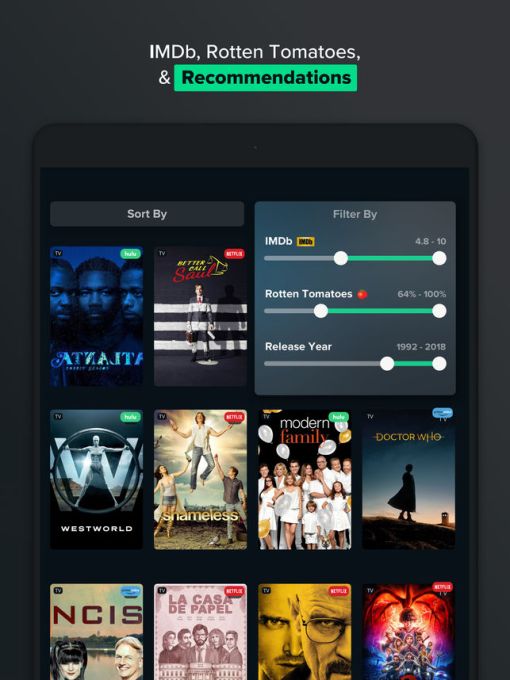
The app also now offers more powerful search and filtering capabilities involving Rotten Tomatoes, IMDb scores, plus cast and crew listings. This allows you to query up things like “Meryl Streep’s top-rated movies” or “drama series with an IMDb rating of at least 8.0 that came out in the last 3 years,” for example.
Reelgood’s search and filtering mechanisms have always been the place where it excels, but it’s less useful as a simple tracker. For that, I prefer TV Time, which lets you quickly mark entire seasons or series as “Watched” and offers discussion boards for each episode where you can post photos and memes and chat with other fans.
TV Time, however, hasn’t been as useful for making recommendations – its suggestions have been off-the-mark when I’ve tried it in the past, often leaning too heavily on network’s back catalogs than pushing me to more current or trending content. It makes me wish I could combine the two apps into one for the best of both worlds – tracking and recommendations.
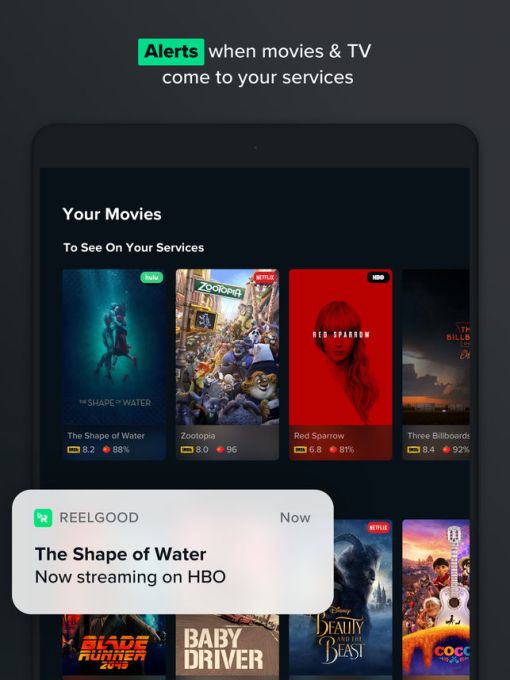
The updated Reelgood app also doubles down on its own curation capabilities by offering editorial collections. For example: 2018 Emmy Nominees, IMDb’s Top 250 Movies, Original Picks, Dark Comedies, British Humour, and more. This can be a good way to find something to watch when you’re really stumped.
And as you discover new shows and movies you want to see, you can set alerts so you’ll be notified when they hit one of the streaming services you’re subscribed to, similar the tracking feature on Roku OS.
Finally, Reelgood’s update includes the addition of 50+ streaming services – that means there’s now support for more niche services like IndieFlix, FilmStruck, Shudder, Fandor, Crunchyroll, Mubi, AcornTV and Starz, among others.
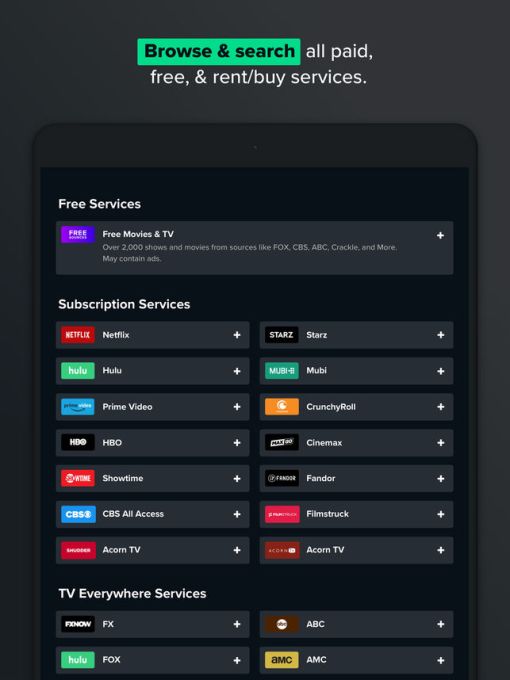
“Reelgood 4.0 is the culmination of all we’ve learned about how people watch and the increasingly fragmented streaming world,” said Eli Chamberlin, Reelgood’s head of product and design. “Our aim with this release was to take all the streaming content out there, and display it in the most meaningful way possible so that people can get the most out of their existing streaming services without wasting countless hours browsing.”
The new app is rolling out to iOS today on the App Store.
Powered by WPeMatico
Amazon’s Alexa app has just been given a major visual overhaul, largely focused on helping users set up and control their smart home. From the app’s new devices tab, users can view all their different Alexa-enabled devices and groups on one screen, as opposed to switching between tabs like before. And the app is much more colorful, too. Instead of a set of white icons on a dark background, Alexa’s device groups — like Living Room, Kitchen, Bedroom, etc. — now feature colorful backgrounds, so you can find the one you need with just a glance.
An overhaul of the devices section was needed, not only for aesthetic reasons, but because Alexa owners are stocking their house with more than one smart device.
According to a Nielsen report on smart speaker adoption released earlier this month, four out of 10 U.S. smart speaker owners today have more than one device, for example. Smart home device sales are also expected to reach nearly $96 billion in 2018 and grow to $155 billion by 2023, another report estimates.
Amazon itself sells a variety of smart devices, like Cloud Cam, Ring doorbells and Ring cameras. And it just introduced a whole mess of new Alexa-enabled devices at an event in Seattle last month, including everything from wall clocks to subwoofers to Alexa-powered microwaves.
It’s clear the retailer expects people to continue to build out their smart home, and its app needed to adapt accordingly.
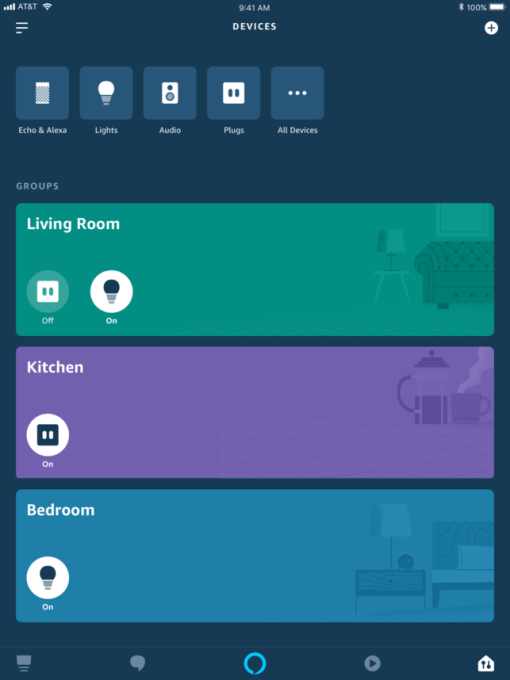
In the new version of the app, the device types are displayed as icons across the top of the screen — starting with “Echo & Alexa” devices, then “Lights,” “Audio,” “Plugs” and others. Below this are the colorful groupings of devices by room, each with their own “On/Off” button.
A small “+” button at the top right of the screen allows you to easily add your newest device, too.
Adding Bluetooth speakers to multi-room music groups is also now supported, the app’s update text says.
The redesign also makes it simpler to call, message or “drop in” on your other Alexa devices — the latter being the feature that turns Echo speakers into a voice-controlled intercom system of sorts, triggered by saying “Alexa, drop in on…” followed by the device name. It’s especially handy for larger homes, where there is an upstairs and downstairs, for example, or for reaching family members in another part of the house. You can also drop in on trusted contacts, like grandma or grandpa.
Now, these communication options each have their own button at the top of the messaging screen in the app, so you can just push a button to call, message or drop in, as you prefer.
The new Alexa app is live on the iOS App Store. Amazon hasn’t made a formal announcement about the changes, as they still be rolling out to users following the update.
Powered by WPeMatico
Consumer messaging apps like WhatsApp are not only insanely popular for chatting with friends but have pushed deep into the workplace too, thanks to the speed and convenience they offer. They have even crept into hospitals, as time-strapped doctors reach for a quick and easy way to collaborate over patient cases on the ward.
Yet WhatsApp is not specifically designed with the safe sharing of highly sensitive medical information in mind. This is where Dutch startup Siilo has been carving a niche for itself for the past 2.5 years — via a free-at-the-point-of-use encrypted messaging app that’s intended for medical professions to securely collaborate on patient care, such as via in-app discussion groups and being able to securely store and share patient notes.
A business goal that could be buoyed by tighter EU regulations around handling personal data, say if hospital managers decide they need to address compliance risks around staff use of consumer messaging apps.
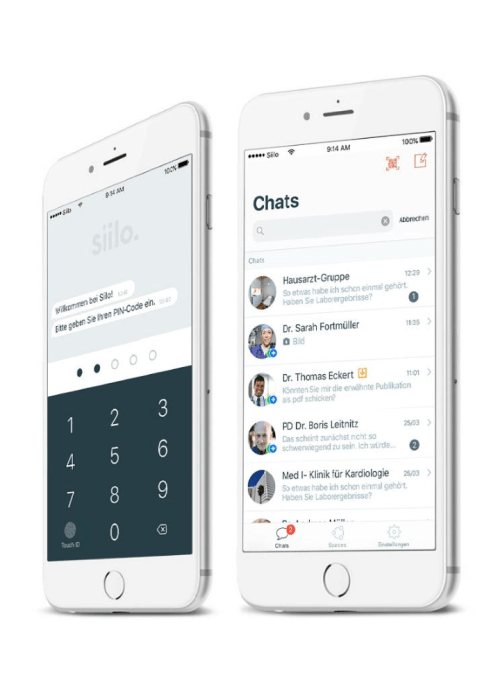
The app’s WhatsApp-style messaging interface will be instantly familiar to any smartphone user. But Siilo bakes in additional features for its target healthcare professional users, such as keeping photos, videos and files sent via the app siloed in an encrypted vault that’s entirely separate from any personal media also stored on the device.
Messages sent via Siilo are also automatically deleted after 30 days unless the user specifies a particular message should be retained. And the app does not make automated back-ups of users’ conversations.
Other doctor-friendly features include the ability to blur images (for patient privacy purposes); augment images with arrows for emphasis; and export threaded conversations to electronic health records.
There’s also mandatory security for accessing the app — with a requirement for either a PIN-code, fingerprint or facial recognition biometric to be used. While a remote wipe functionality to nix any locally stored data is baked into Siilo in the event of a device being lost or stolen.
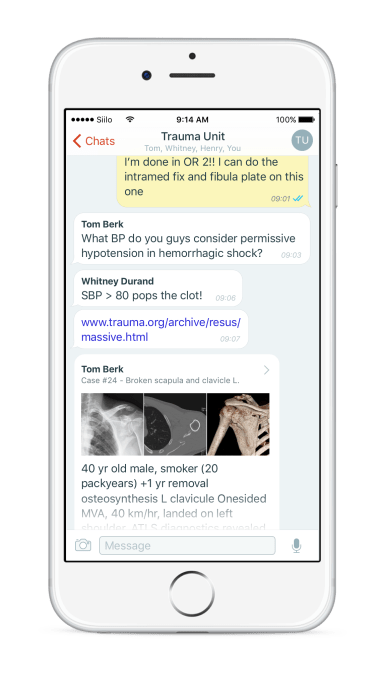
Like WhatsApp, Siilo also uses end-to-end encryption — though in its case it says this is based on the opensource NaCl library
It also specifies that user messaging data is stored encrypted on European ISO-27001 certified servers — and deleted “as soon as we can”.
It also says it’s “possible” for its encryption code to be open to review on request.
Another addition is a user vetting layer to manually verify the medical professional users of its app are who they say they are.
Siilo says every user gets vetted. Though not prior to being able to use the messaging functions. But users that have passed verification unlock greater functionality — such as being able to search among other (verified) users to find peers or specialists to expand their professional network. Siilo says verification status is displayed on profiles.
“At Siilo, we coin this phenomenon ‘network medicine’, which is in contrast to the current old-fashioned, siloed medicine,” says CEO and co-founder Joost Bruggeman in a statement. “The goal is to improve patient care overall, and patients have a network of doctors providing input into their treatment.”
While Bruggeman brings the all-important medical background to the startup, another co-founder, Onno Bakker, has been in the mobile messaging game for a long time — having been one of the entrepreneurs behind the veteran web and mobile messaging platform, eBuddy.
A third co-founder, CFO Arvind Rao, tells us Siilo transplanted eBuddy’s messaging dev team — couching this ported in-house expertise as an advantage over some of the smaller rivals also chasing the healthcare messaging opportunity.
It is also of course having to compete technically with the very well-resourced and smoothly operating WhatsApp behemoth.
“Our main competitor is always WhatsApp,” Rao tells TechCrunch. “Obviously there are also other players trying to move in this space. TigerText is the largest in the US. In the UK we come across local players like Hospify and Forward.
“A major difference we have very experienced in-house dev team… The experience of this team has helped to build a messenger that really can compete in usability with WhatsApp that is reflected in our rapid adoption and usage numbers.”
“Having worked in the trenches as a surgery resident, I’ve experienced the challenges that healthcare professionals face firsthand,” adds Bruggeman. “With Siilo, we’re connecting all healthcare professionals to make them more efficient, enable them to share patient information securely and continue learning and share their knowledge. The directory of vetted healthcare professionals helps ensure they’re successful teamplayers within a wider healthcare network that takes care of the same patient.”
Siilo launched its app in May 2016 and has since grown to ~100,000 users, with more than 7.5 million messages currently being processed monthly and 6,000+ clinical chat groups active monthly.
“We haven’t come across any other secure messenger for healthcare in Europe with these figures in the App Store/Google Play rankings and therefore believe we are the largest in Europe,” adds Rao. “We have multiple large institutions across Western-Europe where doctors are using Siilo.”
On the security front, as well flagging the ISO 27001 certification the company has gained, he notes that it obtained “the highest NHS IG Toolkit level 3” — aka the now replaced system for organizations to self-assess their compliance with the UK’s National Health Service’s information governance processes, claiming “we haven’t seen [that] with any other messaging company”.
Siilo’s toolkit assessment was finalized at the end of Febuary 2018, and is valid for a year — so will be up for re-assessment under the replacement system (which was introduced this April) in Q1 2019. (Rao confirms they will be doing this “new (re-)assessment” at the end of the year.)
As well as being in active use in European hospitals such as St. George’s Hospital, London, and Charité Berlin, Germany, Siilo says its app has had some organic adoption by medical pros further afield — including among smaller home healthcare teams in California, and “entire transplantation teams” from Astana, Kazakhstan.
It also cites British Medical Journal research that found that of the 98.9% of U.K. hospital clinicians who now have smartphones, around a third are using consumer messaging apps in the clinical workplace. Persuading those healthcare workers to ditch WhatsApp at work is Siilo’s mission and challenge.
The team has just announced a €4.5 million (~$5.1M) seed to help it get onto the radar of more doctors. The round is led by EQT Ventures, with participation from existing investors. It says it will be using the funding to scale up its user base across Europe, with a particular focus on the UK and Germany.
Commenting on the funding in a statement, EQT Ventures’ Ashley Lundström, a venture lead and investment advisor at the VC firm, said: “The team was impressed with Siilo’s vision of creating a secure global network of healthcare professionals and the organic traction it has already achieved thanks to the team’s focus on building a product that’s easy to use. The healthcare industry has long been stuck using jurassic technologies and Siilo’s realtime messaging app can significantly improve efficiency
and patient care without putting patients’ data at risk.”
While the messaging app itself is free for healthcare professions to use, Siilo also offers a subscription service to monetize the freemium product.
This service, called Siilo Connect offers organisations and professional associations what it bills as “extensive management, administration, networking and software integration tools”, or just data regulation compliance services if they want the basic flavor of the paid tier.
Powered by WPeMatico
Forward Health, the U.K. startup that has built an app to help healthcare professionals communicate in a secure and compliant way, has picked up $3.9 million in seed funding.
Leading the round is Stride.VC, the new VC fund from Fred Destin, formerly a partner at Accel, and Harry Stebbings, producer of the “The Twenty Minute VC” and most recently Entrepreneur-in-Residence at VC firm Atomico.
Additional backing comes from Albion Capital, while Forward already boasts a decent array of angel investors. They include healthtech founders Jay Desai from U.S. company Patient Ping, and Melissa Morris from U.K.-based Lantum.
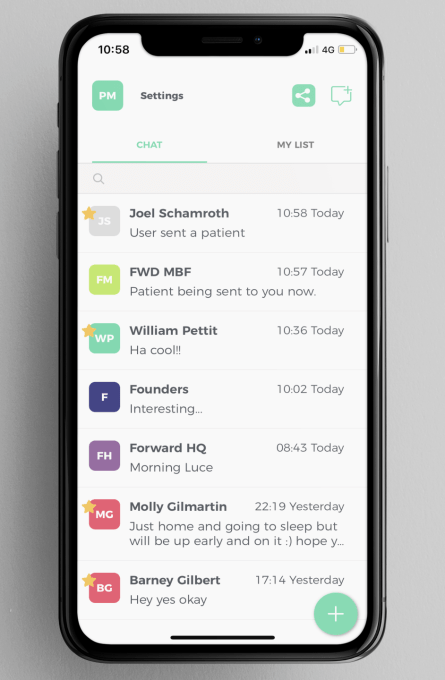 Founded in 2016 by U.K. doctors Barney Gilbert and Lydia Yarlott, with serial entrepreneur Philip Mundy (who previously founded Goodlord), Forward Health is a messaging app and broader communications platform designed for healthcare professionals, particularly those working in hospitals.
Founded in 2016 by U.K. doctors Barney Gilbert and Lydia Yarlott, with serial entrepreneur Philip Mundy (who previously founded Goodlord), Forward Health is a messaging app and broader communications platform designed for healthcare professionals, particularly those working in hospitals.
One overly simple way to think of it is as a “WhatsApp for doctors,” helping to wean healthcare professionals off of using the popular messaging app professionally, which is entirely unsuited for a regulated industry like healthcare. However, the bigger vision is to “connect healthcare systems around the world” by improving clinician-to-clinician (and potentially clinician-to-patient) communication and information-sharing with a platform that is built from the get-go to be secure, flexible and compliant.
“Healthcare communication is incredibly fragmented,” Forward Healthcare’s Mundy tells me. “This has a direct impact on how well clinicians can do their jobs and the level of care patients receive. Currently, doctors and nurses working within the NHS have to rely on an outdated and inefficient combination of pagers, landlines, switchboards and fax machines to contact each other. This 1960s infrastructure wastes huge amounts of time and can lead to critical delays in information flow.”
It is in this context that clinicians have resorted to alternative methods of communication, such as WhatsApp, which Mundy rightfully says are not fit for purpose and pose real risks.
“Any communication of this kind needs to support the exchange of highly sensitive patient information, any app used needs to be NHS digital compliant, GDPR compliant and operate within the highest levels of data security,” he explains. “WhatsApp and others don’t do this, meaning individual doctors could be liable should patient data be sent to the wrong contact or thread. Additionally, an app such as Forward is designed by and for doctors, meaning it can perform in just the right way.”
In Forward’s case, that means offering an in-app directory of healthcare professionals who work within the same hospital so that it is possible to message colleagues even if you don’t know their number, “safe exchange of information and images,” the ability to create task lists and a way of ensuring everyone involved with a patient’s care “is on the same page and working from the same information.” The latter includes the ability for clinicians to share patient cards, akin to a mini electronic health record, on a need-to-know basis.
To that end, the Forward app is GDPR compliant, NHS IG Toolkit Certified and meets the GMC’s confidentiality guidelines. Clinicians must have an approved NHS or Trust email address to log into the app. Over the last year it has been piloted with a community of 5,000 doctors across five partner hospitals.
In a call with Harry Stebbings — who led the round on behalf of Stride and whom I promised not to refer to as a podcaster-turned-VC (sorry, Harry, I’m a terrible person!) — he told me that Forward Health’s mission resonated with him personally due to his first-hand experience of how doctors communicate and share information in the NHS. It is quite well-known that Stebbings’ mother has MS, while more recently his father suffered a heart attack.
“I knew healthcare communication was broken when, post my father’s heart attack, they faxed his ECG scans,” he says, aghast.
When he was introduced to the Forward Health team, Stebbings says he already understood the problem. But, more so, he looks for founder-market fit and believes the Forward founders are extremely well-placed to solve this particular problem, with the right mixture of healthcare and product backgrounds.
He says that another thing that has impressed him is the bottom-up growth that the Forward app has garnered, which we both agree is a little reminiscent to how business social network Yammer originally penetrated corporations. This sees healthcare professionals download the app and sign up using their NHS email address, without the need for a central diktat. They then typically encourage colleagues to do the same, which creates further network effects. This viral growth is also benefiting from the current career path of junior doctors, who, as part of their training, move from hospital to hospital and in turn spread use of the Forward app.
Adds Mundy: “The last year has not only furthered our aims to help thousands of doctors and nurses avoid using pagers and WhatsApp, but it’s also shown us the scale of the clinical communication problem. It’s an issue at every level of healthcare, from A&E to community services, and affects all clinicians and every patient. With this capital, we’ll be able to work with even more clinicians across the U.K. to identify their challenges and expand our product to help solve them. We believe our current offering is just the start of what our platform is set to become.”
Powered by WPeMatico
Adults, not teens. Messaging, not Stories. Developing markets, not the U.S. These are how Snapchat will make a comeback, according to CEO Evan Spiegel . In a 6,000-word internal memo from late September leaked to Cheddar’s Alex Heath, Spiegel attempts to revive employee morale with philosophy, tactics and contrition as Snap’s share price sinks to an all-time low of around $8 — half its IPO price and a third of its peak.
“The biggest mistake we made with our redesign was compromising our core product value of being the fastest way to communicate,” Spiegel stresses throughout the memo regarding “Project Cheetah.” It’s the chat that made Snapchat special, and burying it within a combined feed with Stories and failing to build a quick-loading Android app have had disastrous consequences.

Spiegel shows great maturity here, admitting to impatient strategic moves and outlining a cohesive path forward. There’s no talk of Snapchat ruling the social app world here. He seems to understand that’s likely out of reach in the face of Instagram’s competitive onslaught. Instead, Snapchat is satisfied if it can help us express ourselves while finally reaching even meager profitability.
Snapchat may be too perceived as a toy to win enough adults, too late to win back international markets from the Facebook empire and too copyable by good-enough alternatives to grow truly massive. But if Snap can follow the Spiegel game plan, it could carve out a sustainable market through a small but loyal audience who want to communicate through imagery.
Here are the most interesting takeaways from the memo — and why they’re important:
There were, of course, some downsides to moving as quickly as a cheetah We rushed our redesign, solving one problem but creating many others . . . Unfortunately, we didn’t give ourselves enough time to continue iterating and testing the redesign with a smaller percentage of our community. As a result, we had to continue our iterations after we launched, causing a lot of frustration for our community.
Spiegel always went on his gut rather than relying on user data like Facebook. Aging further and further away from his core audience, he misread what teens cared about. The appealing buzz phrase of “separating social from media” also meant merging messaging and Stories into a chaotic list that made both tougher to use. Spiegel seems to have learned a valuable lesson about the importance of A/B testing.
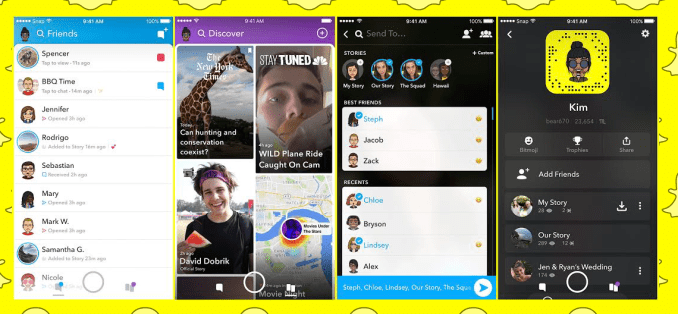
Our redesigned algorithmic Friend Feed made it harder to find the right people to talk to, and moving too quickly meant that we didn’t have time to optimize the Friend Feed for fast performance. We slowed down our product and eroded our core product value. . . . Regrettably, we didn’t understand at the time that the biggest problem with our redesign wasn’t the frustration from influencers – it was the frustration from members of our community who felt like it was harder to communicate . . . In our excitement to innovate and bring many new products into the world, we have lost the core of what made Snapchat the fastest way to communicate.
When Snap first revealed the changes, we predicted that “Teen Snap addicts might complain that the redesign is confusing, jumbling all content from friends together.” That made it too annoying to dig out your friends to send them messages, and Snap’s growth rate imploded, with it losing 3 million users last quarter. Expect Snap to optimize its engineering to make messages quicker to send and receive, and even sacrifice some of its bells and whistles to make chat faster in developing markets.
Your top friend in a given week contributes 25% of Snap send volume. By the time you get to 18 friends, each incremental friend contributes less than 1% of total Snap send volume each. Finding best friends is a different problem than finding more friends, so we need to think about new ways to help people find the friends they care most about.
Facebook’s biggest structural disadvantage is its broad friend graph that’s bloated to include family, co-workers, bosses and distant acquaintances. That might be fine in a feed app, but not for Stories and messaging where you only care about your closest friends. With friend lists and more, Facebook has tried and failed for a decade to find better ways to communicate with your besties. This is the wedge through which Snapchat can attack Facebook. If it develops special features for luring your best friends onto the app and staying in touch with them for better reasons than just maintaining a Snap “Streak,” it could hit Facebook where it can’t defend itself.

Our Shows continue to attract more and more viewers, with over 18 Shows reaching monthly audiences of over 10M unique viewers. 12 of which are Original productions. As a platform overall, we’ve grown the amount of total time spent engaging with our Shows product, almost tripling since the beginning of the year. Our audience for Publisher Stories has increased over 20% YoY, and we believe there is a significant opportunity to continue growing the number of people who engage with Discover content . . .We are also working to identify content that is performing well outside of Snapchat so that we can bring it into Discover.
Discover remains Snapchat’s biggest differentiator, scoring with premium video content purposefully made for mobile. What it really needs, though, are a few must-see tent-pole shows to drag in a wider audience that can get hooked on the reimagined digital magazine experience.
Our content team is working hard to experiment with new layouts and content types in the wake of our redesign to drive increased engagement.
Snapchat Discover is an overcrowded pile of clickbait. News outlets, social media influencers, original video Shows and aggregated user content collections all battle for attention in a design that feels overwhelming to the point of exhaustion. Thankfully, Snapchat seems to recognize that more cohesive sorting with fewer images and headlines bombarding you might make Discover a more pleasant lean-back consumption experience.
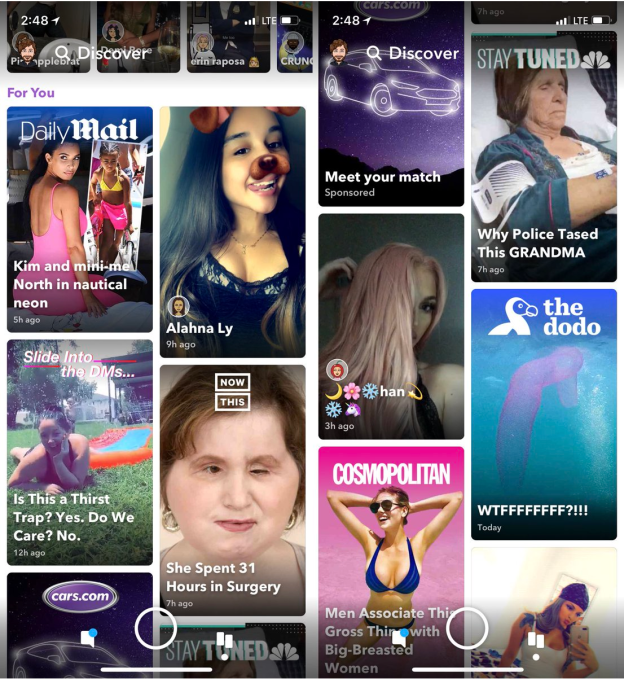
Most of the incremental growth in our core markets like the US, UK, and France will have to come from older users who generate higher average revenue per user . . . Growing in older demographics will require us to mature our application . . . Many older users today see Snapchat as frivolous or a waste of time because they think Snapchat is social media rather than a faster way to communicate. Changing the design language of our product and improving our marketing and communications around Snapchat will help users understand our value . . . aging-up our community in core markets will also help the media, advertisers, and Wall Street understand Snapchat.
Snapchat can’t just be for cool kids anymore. Their lower buying power and life stage make them less appealing to brands. The problem is that Snapchat risks turning off younger users by courting their older siblings or adults. If, like Facebook, users start to feel like Snapchat is a place for parents, they may defect in search of the next purposefully built app to confuse adults to stay hip.
We already have many projects underway to unlock our core product value in new markets. Mushroom allows our community to use Snapchat on lower-end devices. Arroyo, our new gateway architecture, will speed up messaging and many other services . . . It might require us to change our products for different markets where some of our value-add features detract from our core product value.
Sources tell me Snapchat’s future depends on the engineering overhaul of its Android app, a project codenamed “Mushroom.” Slow video load times and bugs have made Snapchat practically unusable on low-bandwidth connections and old Android phones in the developing world. The company concentrated on the U.S. and other first-world markets, leaving the door open for copycats of Stories built by Instagram (400 million daily users) and WhatsApp (450 million daily users) to invade the developing world and dwarf Snap’s 188 million total daily users. In hopes of a smooth rollout, Snapchat is already testing Mushroom, but it will have to do a ton of marketing outreach to convince frustrated users who ditched the app to give it another try.

We’re currently building software that takes the millions of Snaps submitted to Our Story and reconstructs parts of the world in 3D. We can then build augmented reality experiences on top of those models and distribute them as Lenses . . . If our innovation compromises our core product of being the fastest way to communicate, we should consider create [sic] separate applications or other ways of delivering our innovation.
Snapchat has big plans for augmented reality. It doesn’t just want to stick animations over the top of anywhere, or create AR art installations in a few big cities. It wants to build site-specific AR experiences across the globe. And while everything the company has built to date has lived inside of Snapchat, it’s willing to spawn standalone apps if necessary so that it doesn’t bog down its messaging service. That could give Snapchat a lot more leeway to experiment.
Our 2019 stretch output goal will be an acceleration in revenue growth and full year free cash flow and profitability. With profitability comes increased autonomy and freedom to operate our business in the long term best interest of our community without the pressure of needing to raise additional capital.
Snapchat is still bleeding money, losing $353 million last quarter. Snapchat ended up selling 2.3 percent of its equity to a Saudi Arabian prince in exchange for $250 million to lengthen its rapidly shortening runway. And last year it took $2 billion from Chinese gaming giant Tencent. Deals like that could threaten Snapchat’s ability to prioritize its goals alone, not the moral imperatives or developer platforms that would benefit its benefactors. Once profitable, Snapchat won’t have to worry so much about struggling with short-term user growth and can instead focus on retention, societal impact and its true purpose — creativity.

Powered by WPeMatico
This is sure to exacerbate fears that Facebook will further exploit Instagram now that its founders have resigned. Instagram has been spotted prototyping a new privacy setting that would allow it to share your location history with Facebook. That means your exact GPS coordinates collected by Instagram, even when you’re not using the app, would help Facebook to target you with ads and recommend you relevant content. Worryingly, the Location History sharing setting was defaulted to On in the prototype. The geo-tagged data would appear to users in their Facebook Profile’s Activity Log, which include creepy daily maps of the places you been.
This commingling of data could upset users who want to limit Facebook’s surveillance of their lives. With Facebook installing its former VP of News Feed and close friend of Mark Zuckerberg, Adam Mosseri, as the head of Instagram, some critics have worried that Facebook would attempt to squeeze more value out of Instagram. Tat includes driving referral traffic to the main app via spammy notifications, inserting additional ads, or pulling in more data. Facebook was sued for breaking its promise to European regulators that it would not commingle WhatsApp and Facebook data, leading to an $122 million fine.
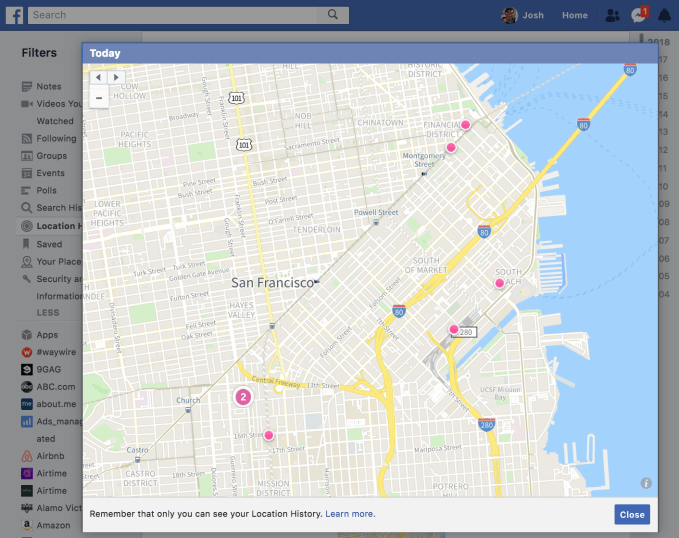
A Facebook spokesperson tells TechCrunch that “To confirm, we haven’t introduced updates to our location settings. As you know, we often work on ideas that may evolve over time or ultimately not be tested or released. Instagram does not currently store Location History; we’ll keep people updated with any changes to our location settings in the future.” That effectively confirms Location History sharing is something Instagram has prototyped, and that it’s considering launching but hasn’t yet.
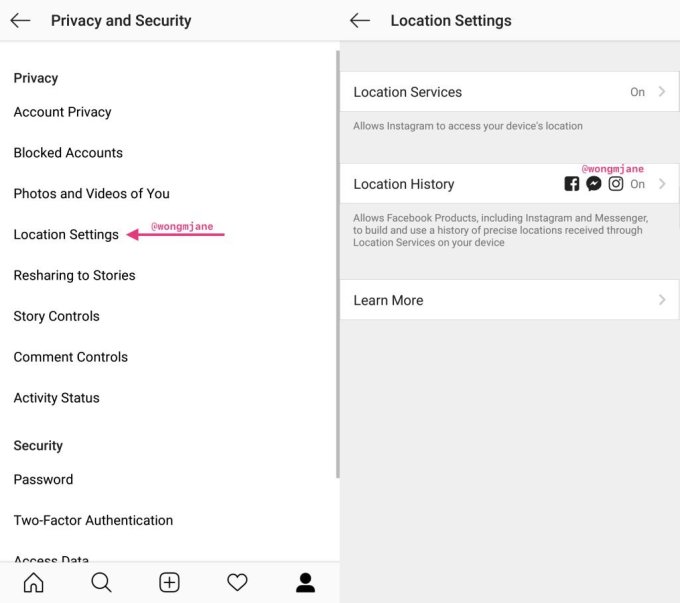
The screenshots come courtesy of mobile researcher and frequent TechCrunch tipster Jane Manchun Wong. Her prior finds like prototypes of Instagram Video Calling and Music Stickers have drawn “no comments” from Instagram but then were officially launched in the following months. That lends credence to the idea that Instagram is serious about Location History.
Located in the Privacy and Security settings, the Location History option “Allows Facebook Products, including Instagram and Messenger, to build and use a history of precise locations received through Location Services on your device.”
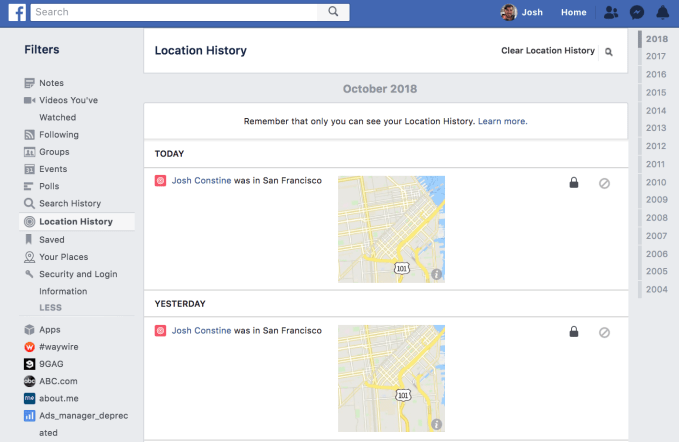
A ‘Learn More’ button provides additional info (emphasis mine):
“Location History is a setting that allows Facebook to build a history of precise locations received through Location Services on your device. When Location History is on, Facebook will periodically add your current precise location to your Location History even if you leave the app. You can turn off Location History at any time in your Location Settings on the app. When Location History is turned off, Facebook will stop adding new information to your Location History which you can view in your Location Settings. Facebook may still receive your most recent precise location so that you can, for example, post content that’s tagged with your location. Location History helps you explore what’s around you, get more relevant ads, and helps improve Facebook. Location History must be turned on for some location feature to work on Facebook, including Find Wi-Fi and Nearby Friends.”
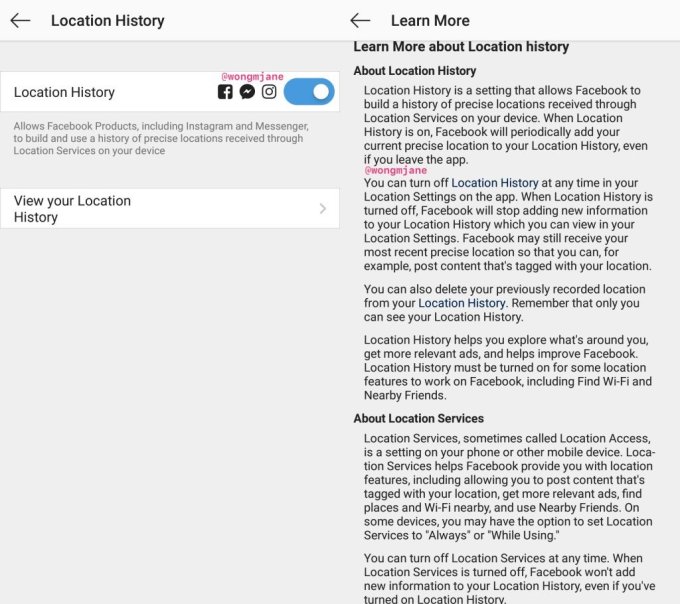
As part of a 2011 settlement with the FTC over privacy violations, Facebook agreed that “Material retroactive changes to the audience that can view the information users have previously shared on Facebook” must now be opt-in. But since Location History is never visible to other users and only deals with data Facebook sees, it’s exempt from that agreement and could be quietly added. Most users might never dig deep enough into their privacy settings to turn the opt-out feature off.
Delivering the exact history of where Instagram users went could assist Facebook with targeting them with local ads across its family of apps. If users are found to visit certain businesses, countries, neighborhoods, or schools, Facebook could use that data to infer which products they might want to buy and promote them. It could even show ads for restaurants or shops close to where users spend their days. Just yesterday, we reported that Facebook was testing a redesign of its Nearby Friends feature that replaces the list view of friends’ locations with a map. Pulling in Location History from Instagram could help keep that map up to date.
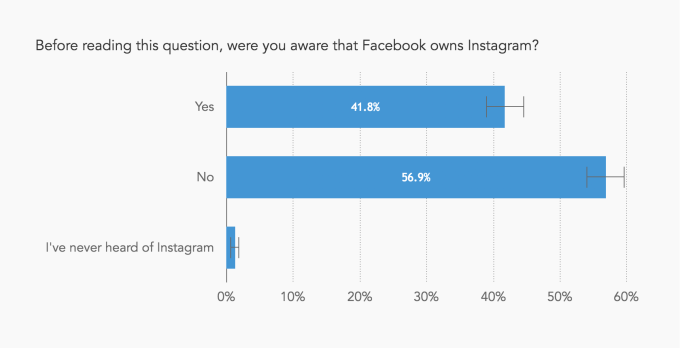
Sources tell TechCrunch that Instagram founders Kevin Systrom and Mike Krieger left the company following increasing tensions with Zuckerberg about dwindling autonomy of their app within the Facebook corporation. Systrom apparently clashed with Zuckerberg over how Instagram was supposed to contribute to Facebook success, especially as younger users began abandoning the older social network for the newer visual media app. Facebook is under pressure to keep up revenue growth despite it running out of News Feed ad inventory and users switching to Stories that advertisers are still acclimating to. Facebook is in heated competition with Google for last-mile local advertising and will take any advantage it can get.
Instagram has served as a life raft for Facebook’s brand this year amidst an onslaught of scandals including fake news, election interference, social media addiction, and most recently, a security breach that gave hackers the access tokens for 50 million users that could have let them take over their accounts. A survey of 1,153 US adults conducted in March 2018 found that 57 percent of them didn’t know Instagram was owned by Facebook. But if Facebook treats Instagram as a source of data and traffic it can strip mine, the negative perceptions associated with the parent could spill over onto the child.
Powered by WPeMatico
When your feed and Stories trays go stale, or your follower count stops rising, you drift away from Instagram . That’s why the app is rolling out two big new features designed to connect you to new people and diversify your graph so there’s always something surprising to look at and like.
Today Instagram launches its QR Snapcode-style Nametags globally on iOS and Android, after TechCrunch broke the news on the feature back in March and April. Though not technically QR codes, they’re scanned like them to let you follow people you meet offline. Here’s a look at how they work:
Now you can quickly add friends on Instagram by scanning their nametags. You can also customize your own nametag with emojis, colors and selfies. pic.twitter.com/fq4HFNiDMy
— Instagram (@instagram) October 4, 2018
The customizable codes are accessible from the three-line hamburger menu on your profile. They can be scanned when other users tap and hold on your code through the Instagram Stories camera or Scan Nametag button on your own Nametag to instantly follow you. You can add colors, emojis or AR-embellished selfies to your Instagram Nametag, show it off on your phone to help people follow you in person, put it on your website or social media or message it to friends through SMS, WhatsApp, Messenger and more.
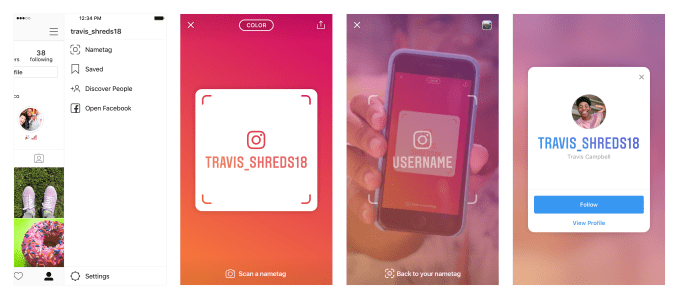
It’s actually surprising it took this long for Instagram to copy Snapchat’s Snapcodes that debuted for profiles in 2015 and were later expanded to open websites and unlock AR filters. Facebook Messenger launched its own QR codes in April 2017, though it never quite caught on. But they make a ton of sense on Instagram because it’s tougher to share links on the app, people often treat it as their primary presence on the web that they want to promote and because businesses are increasingly relying on the app for commerce. It’s easy to imagine brands putting their Instagram Nametags on billboards and posters, or buying ads to promote them around the web.
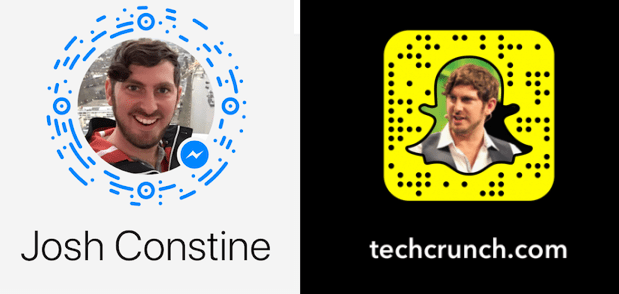
Facebook Messenger and Snapchat’s QR codes
Secondly, Instagram is starting to test school communities in a variety of universities across the U.S. They allow you to join your university’s network to add a line to your profile listing your school, class year and your major, sports team or fraternity/sorority. You’ll show up in a directory listing everyone from your school that you can use to follow or message people, though those DMs may go to their pending inbox.
The school communities feature harkens back to Facebook’s origins, when users could actually set their privacy to show all their content to everyone in their school. Here you won’t be able to instantly expose your private Instagram to everyone from your school. You could imagine a freshman in college going through their network to discover new potential friends to follow, or an alumni seeking others from their alma mater in search of business or romance.
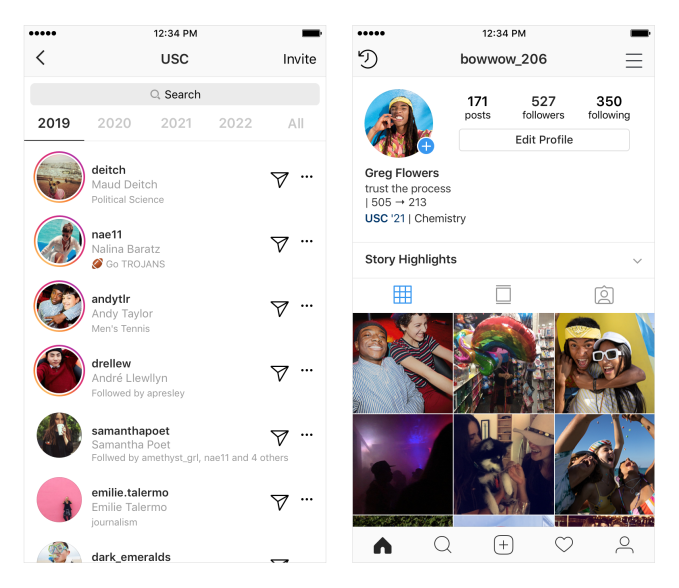
Instagram relies on info users have publicly shared about their school and the people they followed to verify if they were in fact a student or recent alumni of a university. Rather than actively signing up, users will get a notification prompting them to join the network. That’s a lot less reliable than using university email addresses for verification like Facebook used to, but also a lot simpler for users.
The company does provide a tool for alerting it to misuse of the school communities feature in case any sketchy older users are employing it as a stalking tool. Next to each user’s name is an overflow menu of three dots where people can report accounts they don’t think belong in a certain community.
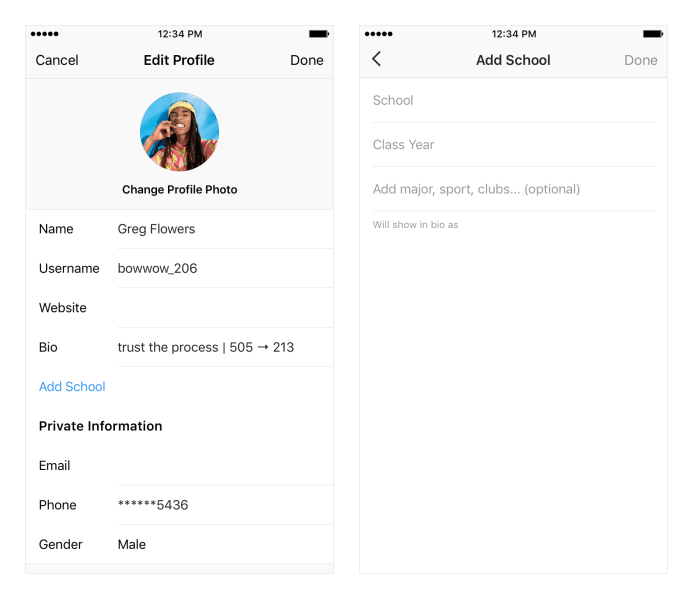
The invite method is reminiscent of the growth hacks that teen Q&A app TBH that Facebook acquired was using. In what an internal memo called a “psychological trick,” TBH scraped Instagram user profiles for school names, looking at school location pages to find student accounts to invite them to join TBH. The teen sensation was eventually shut down due to low usage; the memo called the tactic too “scrappy” for a big public company, but now it’s found a home inside of Instagram.
Today’s launch is the first under Instagram’s new leader Adam Mosseri following the resignation of the company’s founders. Critics are watching to see if Mosseri, the former Facebook VP of News Feed and member of Mark Zuckerberg’s inner circle, will push harder to drive growth and monetization for Instagram. Given Instagram’s priority here is expanding its social graphs and keeping users engaged, it seems willing to trade occasionally allowing or disallowing the wrong people to reduce friction and juice growth.
Powered by WPeMatico
One can only imagine what it was like to work at Uber in the years leading up to Susan Fowler’s infamous blog post. Many of the company’s leaders were said to be overly competitive, sexist and inappropriate — “brilliant jerks,” as Arianna Huffington once said, — and its over-arching “move fast and break things” mentality hardly left room for employees to take a step back and reflect on how the company’s culture was impacting their mental health.
Andrew Chapin joined Uber in 2011 as one of its first hires in New York. He worked his way up to head of vehicle solutions and established Uber’s vehicle finance program, which helps drivers obtain and pay off car leases. He says the struggles within the company gave him severe anxiety, something he was all too familiar with from his stint as a commodities trader at Goldman Sachs.
“There were days when I was walking through lower Manhattan and thinking if I got hit by a car and was in the hospital for a week, it’d be better than going to work,” Chapin told TechCrunch.
At both Goldman and Uber, Chapin would go through rough patches but resisted therapy, in part because of the outlandish costs but mostly because of the hassle. Toward the end of his five-year Uber tenure, he realized the dire need for accessible and flexible tech-enabled tools to help workers endure stressful times, as well as the need to destigmatize the mental health issues prevalent within the tech industry and beyond.
In late 2016, he left Uber to build his own startup. Two years later, he’s ready to share what he’s been working on. Basis, an app meant to help people cope with anxiety, depression and other mental health issues through guided conversations via chat or video, is emerging from stealth today with a $3.75 million investment led by Bedrock. Wave Capital and Lightspeed Venture Partners have also participated in the round.
“Looking back at the Goldman experience of just kind of wallowing in this unpleasant situation, [Basis] would have been an outlet to talk through things and feel lighter,” Chapin said. “At the time, I bottled it up. In retrospect, if I had something to work me through the emotions I was dealing with, it would have been really helpful.”
In the app, users can schedule 45-minute phone calls with unlicensed providers for $35. Because Basis works with paraprofessionals — people trained in research-backed approaches but who don’t have the same certifications as a counseling or clinical psychologist — it’s a much cheaper alternative to paying for a therapist. The startup does not give diagnoses or write prescriptions.
Chapin built the app with co-founder and chief science officer Lindsay Trent, a former research psychologist at Stanford who’d grown tired of watching trained psychologists charge outlandish fees and was hungry for an innovative solution to today’s mental health crises.
“I saw a real gap between what we knew was effective and what people actually received,” Trent told TechCrunch. “Clinicians that are charging $300 a session are not providing optimal care. It’s very frustrating for me.”
Basis provides six pathways: Work, Social, School, Finances, Relationships and Parenting. Within each, users can get same-day access to specialists who they can opt to see on a regular basis or just once.
The idea is that Basis fits into your life much like a SoulCycle class or a call with your best friend — on your terms.
Powered by WPeMatico
Helping friends meet up offline has been a massive missed opportunity for Facebook . Whether because the brand is too creepy or the politely opt-in 2015 rollout of its location sharing feature wasn’t creepy enough, Facebook Nearby Friends never quite took off. Only 103 of my 1,120 friends in San Francisco have it turned on.
It’s not the only one struggling with “The quest to cure loneliness.” Foursquare Swarm, Glympse, Apple’s Find My Friends and Google Maps’ real-time coordinate-sharing option have all failed to become a ubiquitous standard.

The redesigned map homescreen of Facebook Nearby Friends
But last year, Snapchat launched a different take on the idea based on its biggest acquisition ever, French app Zenly. With Snap Map, it wasn’t just about the utility of seeing a list of friends’ locations like on Facebook, but also splayed them out across maps that you could dive into to see their latest geo-tagged Stories. It was as much about fun and content as it was about actually hanging out with people in person.
Now Facebook is testing a significant redesign of Nearby Friends that looks a lot more like Snap Map. It replaces the list view of the neighborhoods and cities friends are in with a map that groups friends together by city. A “view list” button opens up the former homescreen, though in both views you still can only see a friend’s approximate location in a neighborhood or city, not their exact coordinates. Facebook confirms to TechCrunch that “We’re testing a new design for Nearby Friends, a tool people have used for the past four years to meet with their friends in person. People have complete control over whether to use Nearby Friends or not. They can turn it on in the Nearby Friends bookmark.”
That statement both subtly promotes Facebook’s opt-in privacy setting for Nearby Friends while urging people to actually go back and activate it. The screenshot was generated from the code of Facebook’s Android app by mobile researcher and frequent TechCrunch tipster Jane Manchun Wong. Interestingly, after TechCrunch’s inquiry, Wong tells me Facebook appears to have deactivated server-side the ability to access the map feature.
The reason this matters is that Facebook is desperate for engagement, especially amongst younger users who are slipping away from it to Snapchat and Instagram. If revamped with this map and other improvements, Nearby Friends could become a more popular utility that keeps people opening Facebook. Getting more people to share their real-time location could open new opportunities for local ad targeting. And Facebook could benefit from showing it unlocks meaningful offline connections given its recent brand troubles following election interference and calls that it’s the opposite of “time well spent.”
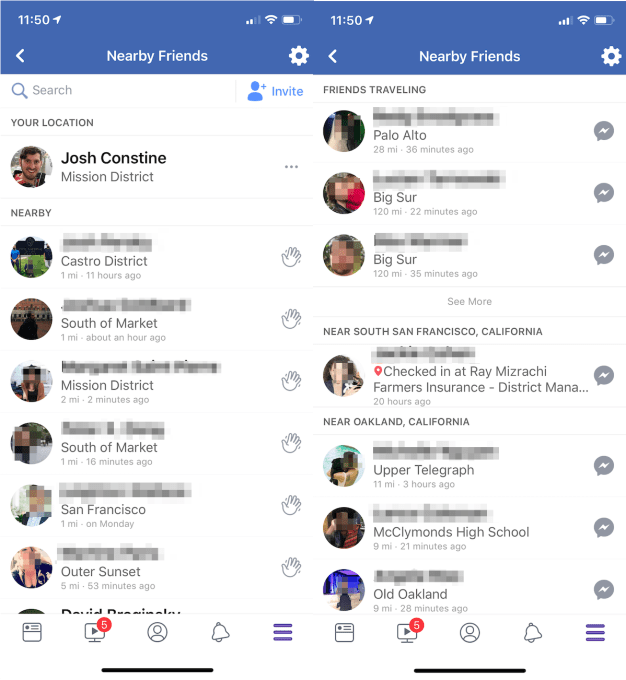
The existing design of Facebook Nearby Friends
Snap Map was smart, but it’s sadly buried behind an awkward pinch gesture from Snapchat’s homescreen, or inside the search bar where some users wouldn’t expect it. Internal Snapchat usage data scored by Taylor Lorenz for The Daily Beast revealed that Snap Map had sunk from a high of 35 million daily unique viewers after its June 2017 launch to just 19 million by that September — merely 11 percent of Snapchat’s users at the time. Users never seemed to cease on it as a method of browsing Snapchat’s geo-tagged content.
Unfortunately, none of these location apps have figured out that meeting up isn’t all about location. It’s about availability. It doesn’t matter if I see my best friend is at a coffee shop right away if they’re not actually available to hang out. They could be on date, having a business meeting or trying to get some work done. If I drop in just because I see they’re close by, it could be awkward. You’d have to first message them, but you can come off seeming desperate if they can’t or don’t want to meet up with you.
Location apps need an availability indicator similar to the green “online” dot used by many chat apps. You could toggle that on if you wanted to show you’re interested in some spontaneous friend time.
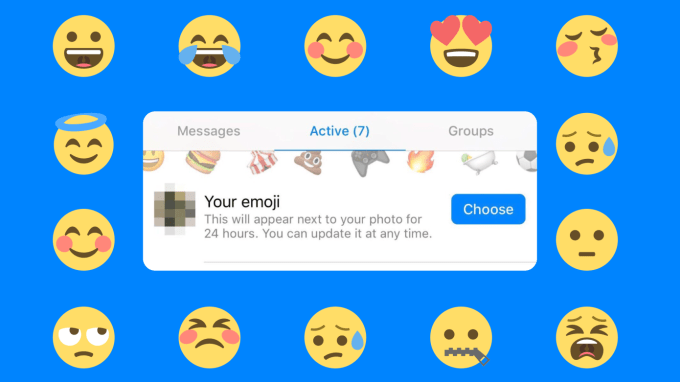
Facebook’s actually spent the last year trying to build this into Messenger in the form of “Your Emoji” status. It lets you pick an emoji like a martini, fork and knife or barbell that’s temporarily overlaid on your profile pic thumbnail to let people know you’re down for drinking, getting dinner or working out. The feature is yet to be widely tested, indicating that Facebook hasn’t quite cracked the nut of encouraging online meetups.
Ideally, Facebook would combine Nearby Friends and Your Emoji to help users share both approximately where they are and whether they want to hang out. The next step would be making it easy to watch a friend’s geo-tagged Facebook Story from wherever they are. And then, Facebook could further copy Snap Map by making public Stories and other location-based content accessible from the map so you could browse it for fun instead of the News Feed or Stories tray.
Still, making Nearby Friends work could require Facebook to rethink the privacy element. The friend graph has bloated to include family, co-workers, bosses and distant acquaintances with whom users might not want to share their real-time location. Finding a better way to let you share where you are with just your closest friends could make more people comfortable with the feature.
Facebook needs to rethink its entire product stack to embrace the high-definition cameras, big phone screens and fast network connections that make it easier to convey information through imagery than text. Visual communication is the future, and that goes far beyond Stories.
Powered by WPeMatico
An updated version of the Twitter mobile app will allow users to gain more control over their data usage – similar to how the Twitter Lite app designed for emerging markets works. Now, instead of having to download a separate app in order to limit data consumption or manually adjust various settings, users will be able to turn on a new ‘Data Saver’ option available in Twitter’s Settings.
Until today, Twitter offered Data Saver in Twitter for Windows, Twitter Lite, and its mobile website. Some users may have also seen the Data Saver option on iOS or Android, as well as on Twitter’s desktop website, because of a test Twitter had underway.
That desktop web test had also included moving other elements and features around, like putting Trends underneath the “Who To Follow” suggestions, for example, or making “Night Mode” a more visible option.
But with the launch today, the Data Saver feature is broadly available to all iOS and Android users, a company spokesperson confirmed.
To take advantage of Data Saver, you’ll visit the Data Usage settings in the iOS or Android mobile app and toggle the option on or off. When enabled, images will load in lower quality and videos won’t autoplay. If you’re browsing Twitter and want to see an image appear in higher quality, you can tap on the three-top menu and pick “Load High Quality” to change the setting on that particular piece of content.
The updated version includes a few other tweaks as well, including a change to make it easier to manage who’s in your group chats, plus VoiceOver improvements in polls, and better labels for some types of Twitter ads, according to the app’s update text in the App Store.
For those who really need to conserve, however, Twitter Lite is still the better option. While Data Saver will consume less data when turned on, Twitter Lite takes up less space on your phone, too.
The new Twitter app is live now, but the features themselves may still be rolling out at this time.
Twitter tells us its @TwitterSupport account will tweet the news later today as Data Saver rolls out to everyone.
Powered by WPeMatico